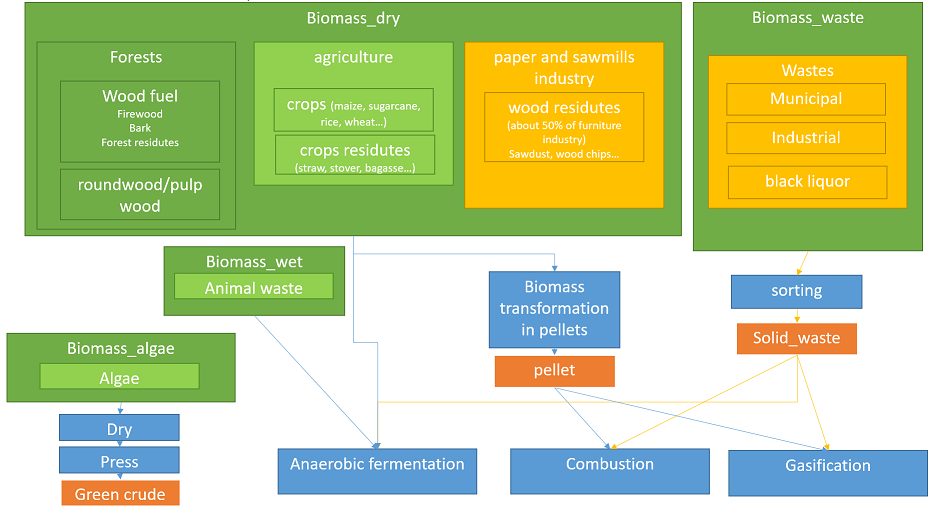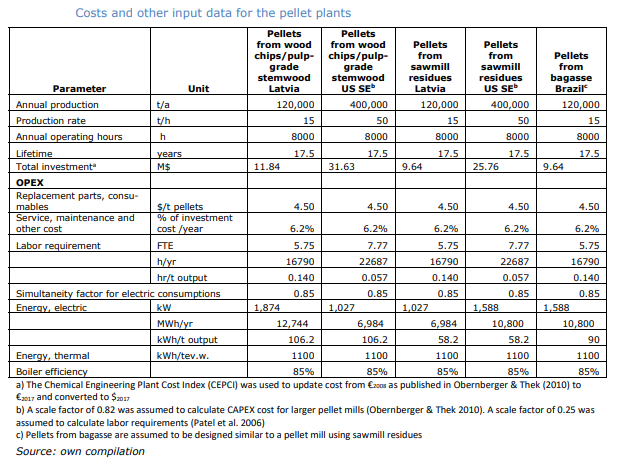Biomass pelletizing
Definition^1 : Biomass comes from organic feedstocks as wood, plants or wastes.
- Wood biomass comes from pulp, paper and sawmill industries, forest residues or energy forestry (grown specifically to provide biomass for heating or power generation).
- herbaceous biomass comes from crops residues or energy crops (providing biomass for energy purpose and not feeding). Algae can also be used as biomass source.
- Wastes biomass comes from municipal or industrial wastes.
It can be converted into heat, electricity, gases or liquid biofuels throught diverse technologies as combustion, gasification, anaerobic fermentation and others. Biomass in SosTrades has been divided following its use.

Biomass problematic^2 : The low energy density of biomass feedstocks tends to limit the transport distance from a biomass power plant. Moreover forests and landfields have to be well managed to stay as sustainable energy source and carbon neutral and therefore large local quantities are not available. This can place a limit on the scale of the biomass power plant, meaning that biomass struggles to take advantage of economies of scale in the generating plant because large quantities of low-cost feedstock are not available.
Transforming biomass into pellets offers a solution to this problem. Biomass is dried, crushed and pelletized to be converted into pellets that have standardized size and properties, high energy content and high density. It reduses costs of transports, storage and handling. Pellets can directly be used in firing or co-firing with coal in boilers.
 (Image Credit: GEMCO, taken from http://www.gemco-energy.com/pellet-mill-dies.html)
(Image Credit: GEMCO, taken from http://www.gemco-energy.com/pellet-mill-dies.html)
DATA
Pelletizing process^3 : The resources needed to produce pellets are raw biomass and electricity (for chipping and pressing).
The quantity of raw biomass depends on the moisture content of the biomass and the produced pellets following this formula:
An average value of the moisture content has been taken at 30% for the biomass and 8% for the pellets.
Pellets investment^4 : Wood pellets represent 90% of the global pellet production. Global wood pellet market was valued at US$10.491 billion in 2019 and is expected to grow at a CAGR of 14.47% over the forecast period to reach a total market size of US$23.604 billion in 2025.
CAPEX and OPEX^5 :
The data used for this model are extracted from the IEA bioenergy file from 2019:

^1: Wikipedia. Biomass. Available at : https://en.wikipedia.org/wiki/Biomass
^2: Irena (2012). Biomass for power generation. Available at : https://www.irena.org/-/media/Files/IRENA/Agency/Publication/2012/RE_Technologies_Cost_Analysis-BIOMASS.pdf
^3: MDPI (2020). Techno-Economic Modeling of Biomass Pellet Routes. Available at : https://www.mdpi.com/1996-1073/13/7/1636/pdf
^4: Globenewswire (2020). Outlook on the Wood Pellet Global Market to 2025. Available at : https://www.globenewswire.com/news-release/2020/11/24/2132562/0/en/Outlook-on-the-Wood-Pellet-Global-Market-to-2025-Europe-is-the-Largest-Consumer-as-Well-as-Producer-of-Wood-Pellets.html
^5:IEA bioenergy (2019). Margin potential for a long-term sustainable wood pellet supply chain - Annexes Available at : https://www.ieabioenergy.com/wp-content/uploads/2019/06/Fritsche-et-al-2019-IEA-Bio-T40-Margin-Pellet-Study-Annexes.pdf, License: CC BY 4.0.